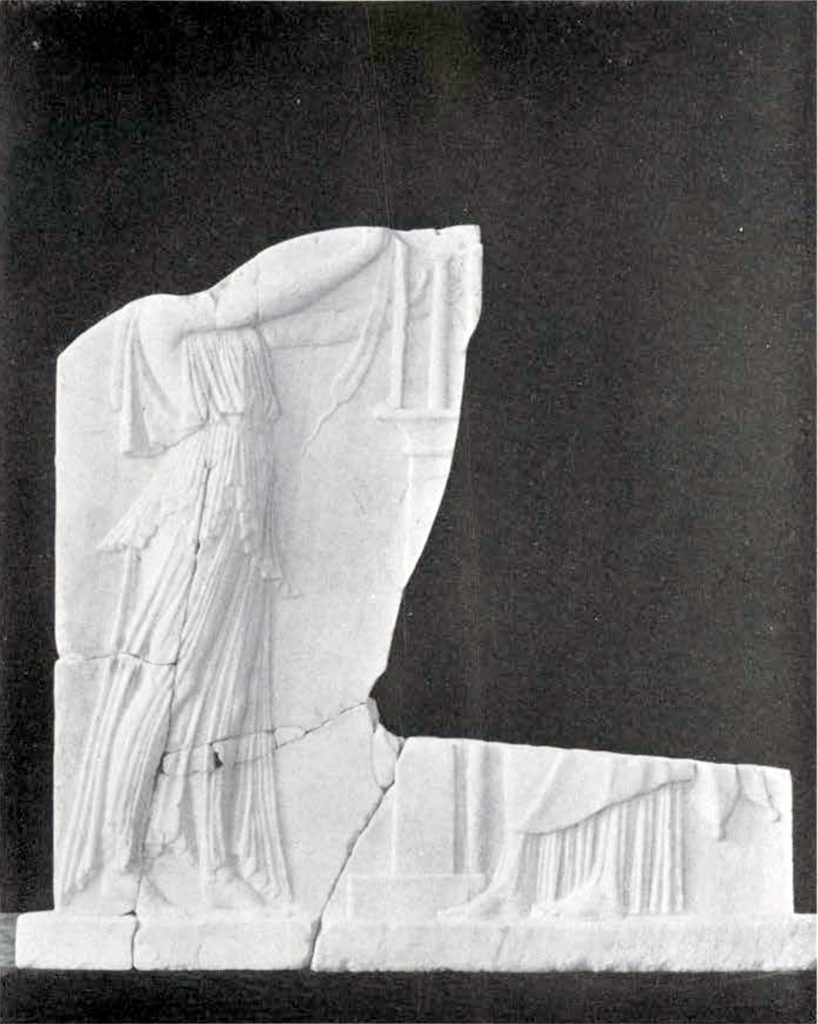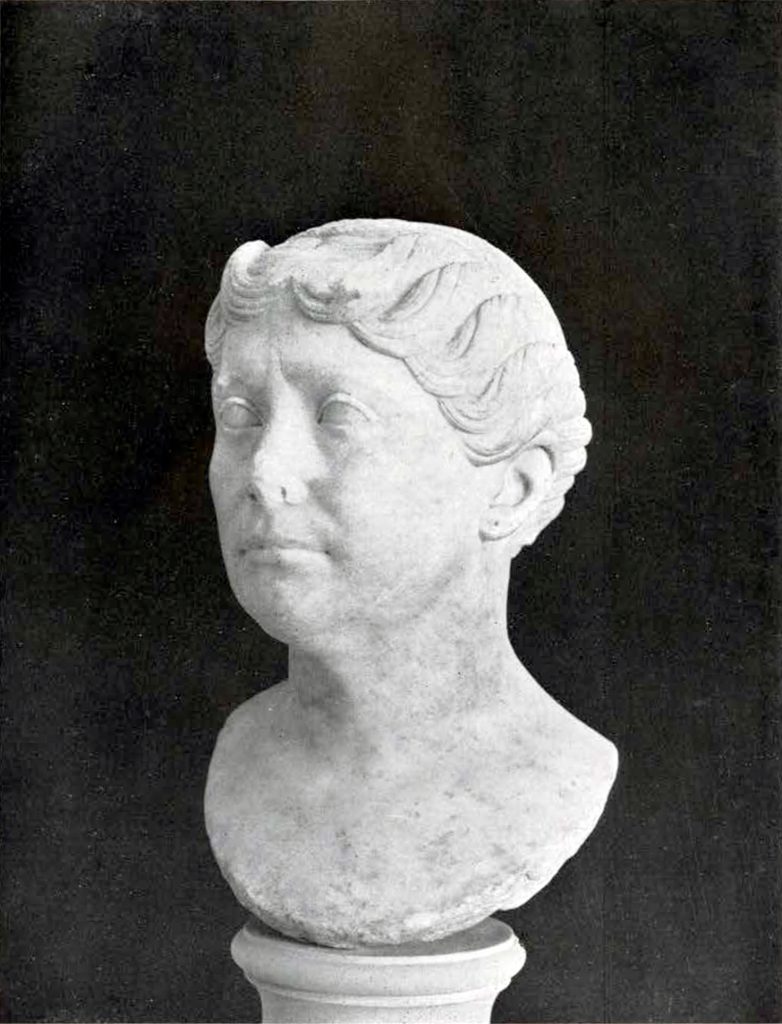Two marbles, acquired by the Museum in the autumn of 1913, are now on exhibition in the newly arranged room on. the second floor. They both date from the Roman era but represent the diametrically opposed methods of two distinct schools of sculpture. The one is a relief of the class called neo-Attic; the other a Roman portrait head.
The relief is carved on a thin slab of marble a large part of which is missing. The original width of the slab, preserved at the base, is 25 inches and the present height 25½ inches. The sculptured surface is patched in several places but in every instance except two with the original fragments. The relief is low and delicately carved. The action is restrained and in general the figures are rendered with poetic feeling. But in spite of this loveliness there is an impression of affectation conveyed both by the irrational attitudes and by the treatment of drapery which is arranged not according to the movement of the figures nor the stirring of the air, but solely with regard to decorative effect. This impression of artificiality is confirmed when, in turning to other works of the neo-Attic school, it is noted that exactly the same figures are there repeated. In the Albertinum at Dresden is a marble base, triangular in section, each of the three faces of which is adorned with a sculptured scene. One of these represents the dispute of Apollo and Herakles for the Delphic tripod ; the other two are commonly interpreted as representing the consecration of a torch and of a tripod. Now the scene representing the consecration of a tripod corresponds in the smallest details with that of our relief. In the center is a marble shaft on which stands a tripod, to the left a maiden or priestess decorating the tripod with fillets, and on the right a bearded priest holding in his hand an object of ritual which is probably to be identified as a thyrsos. Every fold of the drapery, every gesture, every smallest detail of the column and of the thyrsos is repeated in this relief. The single difference is that the bowl of the tripod seems, on our slab, to have been inserted in another material, probably bronze. Nor are these the only two replicas of this scene; it appears again in precisely the same form on two other marble slabs, the one in St. Petersburg, the other in Berlin. Moreover, there are instances where separate figures are transferred bodily from one scene to another. Thus the priest with the thyrsos appears in identically the same form in the midst of a Bacchic revel depicted on a marble vase in Paris.

Museum Object Number: MS4918
Image Number: 4768
The prototypes of these figures which were thus manipulated by artists of the neo-Attic school have been traced by scholars to the Attic art of the early fifth century B. C. The correctness of this attribution can be nicely demonstrated in the case of our relief, for, as a German scholar, Hauser, has shown, the figure of the priest with the thyrsos occurs on a red-figured krater from the collection of Sir John Coghill, which was published in Rome in 1817. This vase dates from about the middle of the fifth century and its decoration is thought to reflect a sculptured group of a slightly earlier period. It is not to be supposed, however, that artists of the neo-Attic school copied directly from archaic works of art. Hardly indeed had archaic art ceased to appear when archaistic art began, and it was doubtless the fourth century and Hellenistic copies of early art which served as models for the neo-Attic sculptors.
The date of this school is somewhat more difficult to fix. Reliefs of the type described have generally been associated with the work of Pasiteles who obtained Roman citizenship in 87 B. C., but it is quite possible that they continued to be produced in the first century of the Christian era. They are essentially a Graeco-Roman product, an adaptation to Roman taste of Greek traditional types.
The other recently acquired marble, a portrait head, is entirely Roman in character. No conventionalized feminine type is here represented, but an individual woman with all her peculiar traits of physiognomy unsparingly rendered.
The head, which was found in Sardinia, is cut from a fine white marble now softened with a yellowish patina. The surface of the stone has escaped treatment with acid and is excellently preserved except where it has been broken. The right ear and the back of the head display broken surfaces which are already oxidized so that it is quite probable that the head had been damaged in antiquity. The other breaks show the white crystals of newly broken marble and were apparently received recently from the tools of the excavators. They include the end of the nose, portions of the hair, and a scratch on the right cheek. The head belonged, it seems, to a statue and did not constitute a separate bust, so that Bienkowski’s test as to the shape of the bust may not be taken as a criterion for date.

Museum Object Number: MS4919
Image Number: 3245
The portrait is that of a woman somewhat past the prime of life. The head is round, and its bony conformation is not once forgotten by the sculptor in rendering a truthful and lifelike portrait. The cheek-bones are prominent and near the surface, the jaw strongly built, and the upper teeth slightly protruding. The restraint with which this last peculiarity is shown is admirable. The flesh which covers the skull is rendered with the same relentless realism. The forehead is wrinkled, the flesh under the eyes a trifle swollen and the cheeks especially at the point just below the cheek-bone somewhat sunken. The mouth is drawn in at the corners with a resulting expression of firmness. There is a suspicion of a double chin and in general the transition of planes from the cheek to the throat and the throat to the neck, which are handled with consummate skill, are just those which characterize the slightly faded beauty of a matron. Combined with these details, the sculptor has managed to convey to his work dignity; the head is erect and well poised, and the features are those of a woman of character and breeding.
A feature quite unusual in Roman portraits is the piercing of the ears for earrings which were doubtless made of bronze. Great attention .is given to the hair which is elaborately dressed. It is parted in the middle and divided into a number of waved tresses which are carried over the forehead on either side, made into a roll behind the ears, and then gathered into two long plaits which encircle the head. This method of dressing the hair is associated with the younger Faustina, the wife of Marcus Aurelius. It occurs both in statues identified as Faustina, and, what is surer evidence, on coins inscribed with her name. On the other hand, the pupils of the eyes are not indicated plastically, and since this method of representing the eye was very generally adopted after the reign of Hadrian, it is probable that this portrait should be assigned to the earlier part of the second century A. D. or even to the latter part of the preceding century.
E. H. H.

